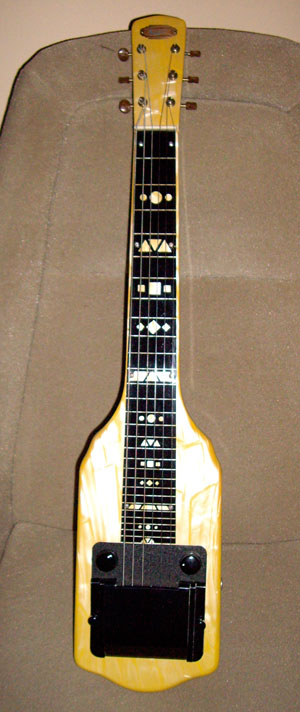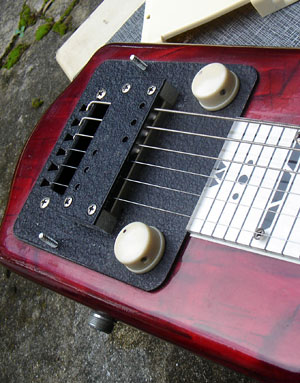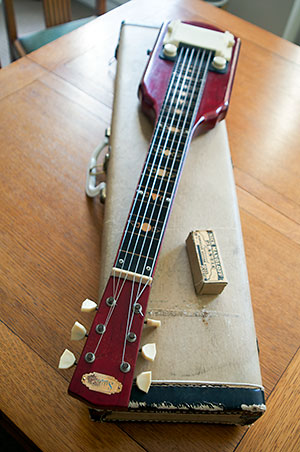1956 Supro Supreme Lap Steel
I've had 3 Supro Supremes.
- A yellow c. 1958 one, bought in July 2006 from Minnesota USA that is shown below and at right, and is now owned by one of my brothers. The serial number was X85685. The colour is not as intense in real life. This one had what appeared to be original Kluson gold sparkle tuner buttons.
- A red 1956 one bought in October 2007 for sentimental reasons (because I was born in 1956). The serial number on that one was X64357. I also got an old bullet type slide with it, and the music books and tuition books from the original owner. That's the one with the cream fingerboard in the photos.
- Another red 1956 one bought in August 2015 from Maryland USA. The serial number on that one is X69583. That one came with an old stevens bar and a very old box for a "Nick Manoloff plastic professional Hawaiian guitar steel". Unfortunately I only got the box, not the steel. That's the one with the dark fingerboard in the photos.
All Supro Supremes have MOTS ( Mother of toilet seat) finish. I believe that the earliest Supro Supreme models were brown (early to mid '50s), then red from about 1956, then yellow in the later part of the '50s.

My second one had a fretboard that was transparent perspex, and over the dark red colour (see photo below) it was really hard to see where you were, especially under low light. So I put some cream paper under the perspex (see photos at right). It's possible that it wasn't the original fretboard. While the markings match the 1958 one above, it has different markings to the other 1956 model that I bought later (see below).
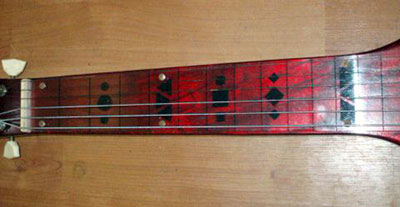
I sold this red 1956 one in October 2009 because I had another Supro (a 1954 Supro Comet), and I wanted to diversify a bit. Soon after that I bought a 1960 Fender, a Gretsch (also made by Valco) and a late '40s Rickenbacher.
In August 2015 I bought another '56 model. It was pretty much identical except for the fingerboard, as you can see from the photos. My first '56 has the cream fingerboard in the photos (see photo on the right although it's transparent in the photo above), whereas the second one has a black board with metallic position markers, shown below. When I removed the board there was a sheet of what looked like aluminium foil, under the perspex. It was obviously very old (discoloured in places and also stuck to some surfaces). The catalogue below says this model has a "sparkling transparent third dimensional fingerboard backed with gleaming gold". The gold colour seems to have faded to silver in many areas of my fingerboard. In any event it's curious that this one has a completely different fingerboard to my previous 1956 one, leading me to believe that the earlier one may have had the fingerboard changed.
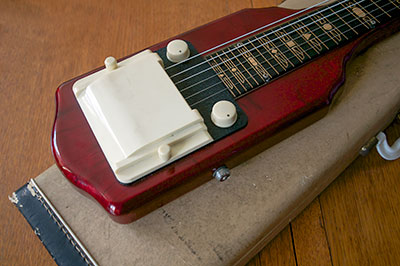
In the 1956 Supro catalogue this is listed as a Model 1400 E "Supreme" Hawaiian Electric at a price of $69.95 plus $12.75 for a hard shell flannel lined case. The 1956 catalogue also says "in brilliant new colour - Accordion Red", indicating that this was probably the first year that the red ones were made. Certainly in the 1954 catalogue that I have, the Supreme is described as "glossy rich brown washable plastic finish".
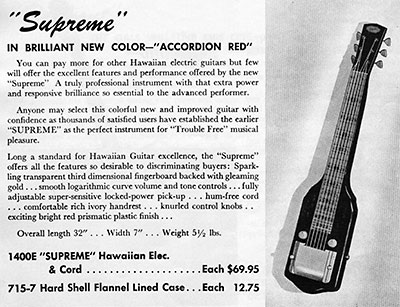
1956 Supro catalogue
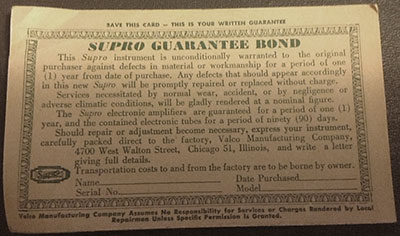
Supro warranty - exact date unknown
Note the fairly ornate tuner buttons on the 1956 models - these are the original Kluson tuners and were in amazing condition on both of my '56 models. Usually they are disintegrating after 50 years.
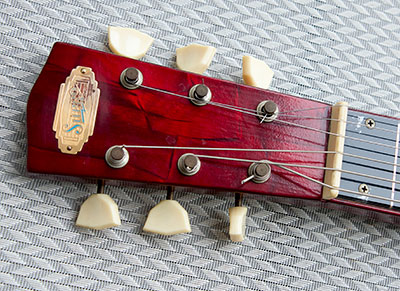
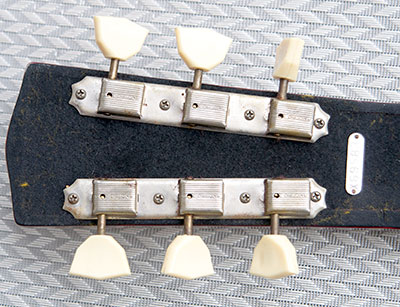
Also note the original screw-on cable connection in the photo below. Apparently all microphones in the old days used to have connections like this. I had to buy a few old leads from the US and have new leads made up using the old hardware.
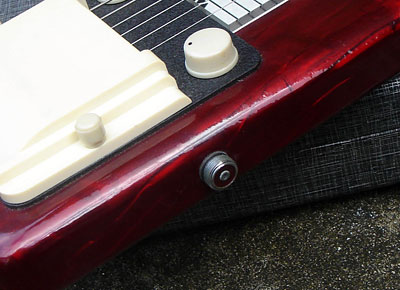
These Supros have a reputation for having incredibly hot pickups, and they certainly have a sound of their own. They are a particular favourite of Ry Cooder who put one of these pickups on a Stratocaster, now known as "The Coodercaster." I can't remember where I found the article below, but for what it's worth here it is. There is a video on YouTube in which he talks about his slide guitars, including this one. Go to about the 11 minute 30 second mark. You can also see him play this guitar in the movie "Buena Vista Social Club."
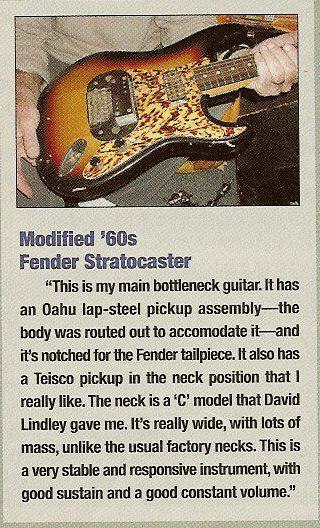
A company named Lollar now produces a substitute for these pickups. According to their web site "The steel plate that goes over the strings spreads the magnetic field to surround the strings. This increases the pickup's sensitivity and reduces magnetic pull on the strings which increases sustain".
History
This is from an ad on ebay and I cannot vouch for its accuracy, but from what I have read elsewhere it seems plausible.
The Supro brand began in 1935 as a line of guitars being made by National-Dobro, the famous line of resonator guitars and electric slides. The Supro brand followed its brother lines as the mother company Valco was born in 1936 as part of a move from California to Chicago. Valco's name was an amalgam of Valco's primary owners first names (Victor Smith, Al Frost, and Louis Dopyera), and with the move saw a shift from acoustic instruments to amplifiers and electric instruments.
It was a company that was on the cutting edge, and its innovations of this time include the first archtop with no soundhole for fighting feedback, and first 2-pickup electric guitar, a 6-coil pickup, and some of the most deluxe double and triple neck slide guitars ever produced. They embraced a very ornate, Art Deco and early Moderne look to many of their guitars, with beautiful ornate Egyptian influenced motifs for position markers and spare two tone streamline body designs that recall the designs of concept cars of the day. They were truly on the cusp of culture and taste through the 1940s.
By the late '50s and early '60s, Valco had grown to be an enormous manufacturer, and had several brands it was making and marketing itself, such as National and Supro, as well as a ton of others being distributed under other brands like Airline (Montgomery Wards), Oahu, Bronson, Silvertone (Sears), Custom Kraft, Gretsch and many others. Many models were almost identical under different brands, often with a different logo, pickup configuration, or sometimes a different finish. Without a doubt they saved their high end models for the National and Supro brands.
They made a lot of excellent guitars in this period, and some of their most collectible designs now fetch big bucks. Their 'Res-o-glass' bodied guitars, which was a method they used for making lightweight, ultra-stylized and durable bodies out of molded fiberglass, were very 'jet-age' and futuristic and very high quality.
More Info
- Supro / National guitar care booklet from 1950 [PDF - 22.5mb]
- Brad's Page of Steel
- Valco Serial Numbers
- Greg Cutshaw - Steel Guitar
- String gauge guide
This is intended for pedal steel but is also useful for lap steels. - My string gauges
- Lap steel capos
